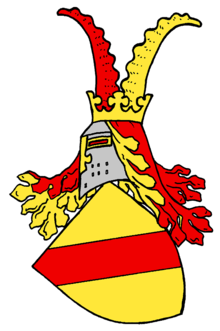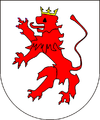Margraviate Baden-Hachberg
The margraviate of Baden-Hachberg was created around 1212 by splitting off from the margraviate of Baden . Heinrich I and his brother Hermann shared the inheritance of their father Hermann IV, who died in 1190. The margraviate existed as an independent territory until Otto II von Hachberg sold his property to the margrave Bernhard I von Baden in 1415 . In the margraviate of Baden - later the margraviate of Baden-Durlach - the territory formed the Oberamt Hochberg .
history
1212-1306
Ancestral castle was the stronghold on the Hachberg near Emmendingen . In the course of the 13th century, the Hachberger line was able to assert itself against the competition of the Counts of Freiburg in the area between the Black Forest and the Rhine ( Breisgau ).
1306-1415

1306 took place between the third Hachberg margrave Heinrich III. (1290-1330) and his brother Rudolf I (1290-1313) a division of the estate, as the direct result of which Hachberg and the city of Emmendingen were transferred to Heinrich. Between 1390 and 1409 there was a conflict with the Counts of Fürstenberg over the Prechtal rule , which was then resolved by the construction of a condominium .
Rudolf received the rule of Sausenberg with the new ancestral seat, the Sausenburg , and thus the bailiwick of the priests Bürgeln , Sitzenkirch and Weitenau of the St. Blasien monastery . In 1315 the rule of Rötteln came to the margraves of Hachberg-Sausenberg and in 1444 the rule of Badenweiler .
The margraviate with ancestral seat in Hochburg existed until 1415, when Margrave Otto II von Hachberg sold the castle and rule of Hachberg to his distant cousin, Margrave Bernhard I von Baden , after the Hachberg-Sausenberg branch line had not been offered. With the death of Otto II in 1418, the Hachberg-Hachberg line became extinct.
While the margraviate of Baden-Hachberg came to an end as early as 1415, the southern margraviate of Hachberg-Sausenberg did not return to the main line in the persona of Christoph I of Baden until 1503 ("Röttelsche Gemächte").
1584-1590
From 1584 to 1590 there was a new edition of the margraviate of Baden-Hachberg when Jakob III. from the Baden-Durlach line, the area was assigned when the country was divided with his brothers Ernst Friedrich and Georg Friedrich .
overview
Margraves
| seal | Name (life data) | Reign | Remarks |
|---|---|---|---|
|
Heinrich I (* before 1190; † July 2, 1231) |
1190-1231 | Founder of the Hachberg branch of the House of Baden after the division of the country (around 1212) with his brother Hermann V. von Baden | |

|
Heinrich II. (* Before 1231; † around 1297/1298) |
1232-1290 | hands over the government to his son in 1290 and becomes a knight of the Teutonic Order |

|
Henry III. († 1330) |
1290-1330 | agreed a further division of the country with his brother Rudolf in 1306, as a result of which the margraviate of Baden-Hachberg lost its southern territories to Hachberg-Sausenberg |

|
Heinrich IV. († around 1369) |
1330-1369 | can not assert his claim to Kenzingen and the Kirnburg against the Habsburgs |
|
Otto I. († July 9, 1386) |
1369-1386 | falls in the battle of Sempach in the service of the Habsburgs | |
|
Johann († 1409) |
1386-1409 | after the death of his brother Otto, power was divided with his brother Hesso; Johann received half of the stronghold , the village of Bahlingen am Kaiserstuhl and compensation payments. | |
|
Hesso († 1410) |
1386-1410 | After the death of his brother Otto, power was divided with his brother Johann | |

|
Otto II († 1418) |
1410-1415 | inherits the parts of the country from his father Hesso and his uncle Johann and in 1415 sells the entire margraviate to Bernhard I of Baden |
The Margraves of Hachberg had their burial place in the Tennenbach Monastery .
coat of arms
The emblem of the Margrave of Baden-Hachberg corresponded to the yellow-red-yellow stem Coat of arms of Baden , however, was in contrast to the main line, the first buffalo horns with Linde branches used with Capricorn horns as crest out.
However, the combination of the Baden family coat of arms with the coat of arms of the Hinteren Grafschaft Sponheim , which Jacob I of Baden used from 1444, is also regarded as the Hachberg coat of arms .
In addition, from Margrave Ernst I of Baden-Durlach, the “ Breisgauer Lion” - actually the seal of the Free County of Burgundy , which was mistakenly held for the family coat of arms of the Zähringer family - was used as a symbol for the Margraviate of Hachberg, for example in the great coat of arms of the Grand Duchy Baden until 1830 .
religion
The independent existence of the margravate ended before the Reformation . Baden-Hachberg was later part of the margraviate of Baden-Durlach , where the Reformation was introduced in 1556.
Under James III. there was an attempt to reintroduce Catholicism in 1590 , which was prevented by the unnatural death of Jacob in the same year.
Localities
Before selling it to Margrave Bernhard von Baden for Markgrafschaft Hachberg included in accordance with the 1414 established Urbar Gülten and slope in the following localities:
| Possessions | Year of purchase | Remarks | coat of arms |
|---|---|---|---|
| Hochburg | |||
| Emmendingen |
|
||
| Vorderesexau and Tal Sexau | 1344 | the Monastery Andlau bought |
|
| Broad plane | |||
| Denzlingen | 1305 |
|
|
| Bahlingen am Kaiserstuhl |
|
||
| Teningen | 1356 | until then belonging to the Counts of Freiburg ; the district Heimbach did not belong to the margraviate, but to front Austria - but Hachberg was wealthy in Heimbach |
|
| Freiamt |
|
||
| Ottoschwanden | 1344 | bought from Andlau Monastery |
|
| Weisweil | 1352 | by Friedrich von Üsenberg |
|
| Prechtal reign | 1409 | Fief of the Counts of Habsburg-Laufenburg ; Condominium with the Principality of Fürstenberg |
|
| Mundingen |
|
||
| Malterdingen |
|
||
| Eichstetten | 1395 | Fiefdom |
|
| Bischoffingen | with goods in Oberbergen |
|
|
| Höhingen Castle | |||
| Vogtsburg |
|
||
| Your singing |
|
The villages of Hochstetten , Niederrimsingen , Achkarren , Leiselheim , Münchweier and Sulzburg were pledged in 1414.
In the course of history, other localities belonged to the margraviate of Baden-Hachberg at times, in particular the city of Kenzingen and, from 1405, Vörstetten , which, however, was temporarily granted as a fief. In the period 1584–1590 Gundelfingen was also part of the margraviate of Baden-Hachberg.
The Sausenberg lordship that belonged to the margraviate of Baden-Hachberg until 1306 is not listed here.
See also
- List of coats of arms in the district of Emmendingen
- List of coats of arms in the Breisgau-Hochschwarzwald district
literature
- Regesta of the Margraves of Baden and Hachberg 1050–1515 , published by the Baden Historical Commission, edited by Richard Fester , Innsbruck 1892 ( digitized in the Open Library )
- Richard Fester: The acquisition of the dominions of Hachberg and Höhingen by Margrave Bernhard I of Baden , in: Journal for the history of the Upper Rhine Volume 49, 1895, pp. 650–667 ( digitized in the Internet Archive )
- Johann Christian Sachs: Introduction to the history of the Marggravschaft and the Marggravial old princely house of Baden . First part. Lotter, Carlsruhe 1764 ( limited preview in Google book search).
- Wilhelm Ludwig Willius : Description of the natural condition in the Marggravschaft Hochberg . Verlag der Valentin Bischoffischen Kunst- und Buchhandlung, Nuremberg 1783 ( digitized version of the Zurich Central Library )
- Christian Philipp Herbst: Hachberg Castle in Breisgau, mainly from the sixteenth century , Karlsruhe 1851 in the Google book search
- Thomas Alfried Leger: Hochberg, Hachberg. In: AG Hoffmann: General Encyclopedia of Sciences and Arts , Second Section, Part Nine, Leipzig 1832, pp. 110–117 ( digitized from Google Books )
- Werner Rösener : The role of manorial rule in the process of territorialization. The Margraviate of Hachberg as an example. In: Schau-ins-Land , Volume 98 (1979), pp. 5–30 ( digitized version from Freiburg University Library )
Web links
Individual evidence
- ↑ Hans Jakob Wörner : Das Markgräflerland - comments on his historical career , in: Das Markgräflerland 2/1994 (anniversary volume), p. 58f.
- ↑ Armin Kohnle : Little History of the Margraviate Baden , G. Braun Buchverlag, Karlsruhe 2007, ISBN 978-3-7650-8346-4 , pp. 62/63.
- ^ Franz Zell: History and description of the Baden coat of arms from its creation to its present form , Karlsruhe 1858, p. 18/19 ( digitized at Google Books ).
- ↑ Kleine Wappenkunde , Badische Zeitung , August 7, 2015, accessed on July 16, 2019.
- ^ Franz Zell: History and description of the Baden coat of arms from its creation to its current form , Karlsruhe 1858, pp. 20/21 ( digitized at Google Books ).
- ^ Franz Zell: History and description of the Baden coat of arms from its creation to its present form , Karlsruhe 1858, p. 9 ( digitized at Google Books ).
- ^ Franz Zell: History and description of the Baden coat of arms from its creation to its current form , Karlsruhe 1858, p. 35 ( digitized at Google Books ).
- ↑ s. Fixed p. 653
- ^ Denzlingen - old community ~ part of town. leo-bw.de , accessed on March 24, 2018 .
- ↑ III. Perspectives: The example of the Niederungsburg Vörstetten. burgen.uni-freiburg.de, accessed on March 24, 2018 .
- ^ Locations of the Hachberger Land in the 16th century (almost unchanged until 1806) ( Memento from April 12, 2013 in the web archive archive.today ), hachberg-bibliothek.de.




